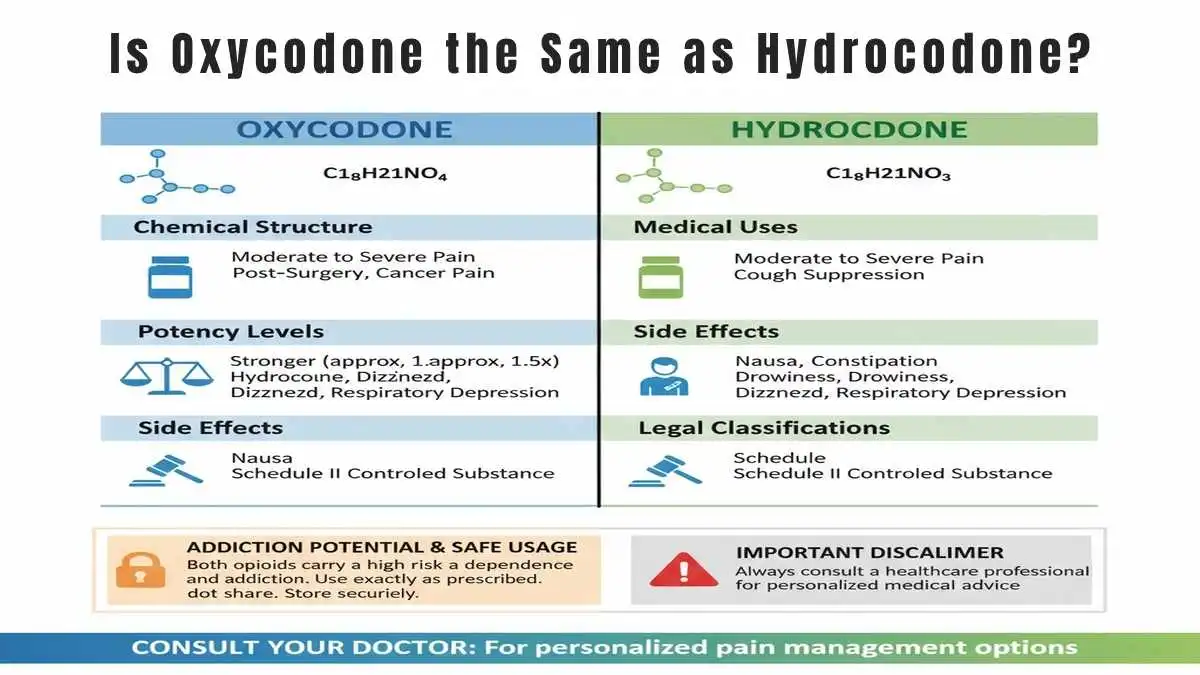HEALTH AND FITNESS
Is Oxycodone the Same as Hydrocodone? A Complete Guide

Relieving pain with prescription medications is essential in some situations, but it comes with risks. Some of the most prescribed opioids in the United States are Oxycodone and hydrocodone. Due to the way the names are structured and their common effects, it is common to ask, Is Oxycodone the same as hydrocodone?
To answer this question, this article will cover the most critical information about these two powerful drugs and why it is important to know them in regard to pain management and addiction treatment. If you, or a loved one, is asking if Oxycodone is the same as hydrocodone, you have come to the right place.
Table of Contents
Why This Question Matters
Not understanding the risks and effects of taking opioid medications is dangerous and can lead to drastic life changes. Even though both Oxycodone and hydrocodone are closely associated with the treatment of moderately and severely hurting patients, the formulations, potencies, side effects, and even abuse potential differ.
Relapse is a very real possibility. This is especially true with the opioid crisis, as it is easy to lose control of prescribed drugs even in a clinical setting. It is understandable why gaining knowledge is crucial in making safer choices and taking preventative measures.
What is Oxycodone?
Oxycodone is a kind of opioid. It is a medication that is most often prescribed to patients suffering from either acute or chronic pain. Oxycodone is commonly known to appear in OxyContin or in Percocet (which, in Oxycodone, is paired with acetaminophen).
Oxycodone works by opioid receptors in the brain and the spinal cord. It acts to block pain signals and helps relieve pain and induce mild euphoria.
What is Hydrocodone?
Just like the rest of the semi-synthetic opioids, hydrocodone also comes from the opium poppy. It is prescribed to opioid-dependent patients suffering from mild to moderately severe pain. It is commonly found in acetaminophen combined medications like Vicodin and Norco.
Just like any opioid medication, the patient also feels euphoria, drowsiness, or sedation, which heightens the chances of addiction if abused.
In What Ways are They Similar?
Many people find it hard to differentiate between which is which. When looking at a prescription bottle or listening to a doctor speak, many tend to wonder if Oxycodone is the same as hydrocodone. Some of the major differences are:
- Action of the drugs: Both relieve pain through binding to opioid receptors
- Prescription usage: Frequently given after surgeries and during recovery from an injury
- Controlled substances: Both are classified under Schedule II due to the possibility of being abused
- Formulations: Both available as immediate release and extended release
- Potential for addiction: Both are highly addictive if used for a prolonged time and not under the prescription guidelines
Some differences must not be overlooked.
Key Differences Between Oxycodone and Hydrocodone
While both are opioids, there is a difference in the way the body responds to each, how the drugs are dispensed, and the effects caused.
1. Potency
In comparison to hydrocodone, Oxycodone is slightly more potent. Which means, from a milligram-to-milligram basis, Oxycodone will bring with it a stronger dose of relief. As a counter side, it will also bring with it an increased possibility of misuse and an overdose, if not taken according to prescription.
2. Side Effects
While there are numerous side effects from both, drowsiness, constipation, and nausea are the more common ones. Some studies and patients report that more sedation is caused by hydrocodone, while Oxycodone tends to increase the discomforting sensations caused by dizziness and euphoria.
3. Drug Combinations
Hydrocodone is commonly prescribed alongside acetaminophen, while Oxycodone is available both as a single entity and in combination with acetaminophen. This distinction is critical as high amounts of acetaminophen can cause liver damage acutely.
4. Abuse Potential
Due to its strength and euphoric effects, Oxycodone can be considered to have a somewhat higher potential for abuse. That said, hydrocodone has a considerable potential for abuse, especially in large doses and in combination with other drugs.
How they are prescribed
The decision of which opioid to prescribe is dependent on the patient’s medical background, as well as the reported pain level and other medicines currently in use. Some prescribe hydrocodone for moderate pain as it has a slightly milder profile, and instead prescribe Oxycodone when pain relief is more critical.
It is not unusual for these patients to be oscillated between the two, depending on bodily reactions or if side effects become unmanageable.
Risk of Dependence and Addiction
Almost all medications and prescription drugs carry the risk of addiction, whether obtained legally or illegally. Even patients with prescriptions can develop physical dependencies if left unchecked. An addiction stems from the body’s craving for the drug when the medication is no longer required, and a medical prescription is not held.
Misusing medication can arise from many quarters. Some of the common ones include:
- Taking more than instructed without medical supervision
- Taking the drug more often than prescribed
- Snorting or rapidly administering pills in an attempt to achieve the effects more quickly
- Mixing the prescribed opioid with alcohol or other drugs
Identifying the issue as early as possible can help stem the tide of potential long-term damage while also creating an opportunity to recover.
Overdose Risks
Opioid overdosing is an extreme threat in the United States, and Oxycodone and hydrocodone are responsible for thousands of fatalities due to overdosing every year. Exceeding the prescribed dosage of any drug, in addition to combining with alcohol and/or any other depressants, can drop the breathing rate to worrying levels and is occasionally fatal. Signs of overdose include the following:
- Infrequent or insufficient breathing
- Skin that is cold and sweaty
- Extremely small pupils
- Unresponsive state
- Discolored lips or fingers
The suggested remedy is calling 911 and administering naloxone if needed.
Withdrawal Symptoms
Intense psychological and physical symptoms are experienced when hydrocodone or Oxycodone is suddenly stopped. The main withdrawal symptoms include:
- Extreme body pain
- Constant urge to move or trouble falling asleep
- Agitation or panic
- Hot, sweaty, or freezing
- Nausea, throwing up, or loose stools
- Insatiable need
Always recommend doing this under the supervision of a physician. The withdrawal should be part of an overall strategy that offers psychological support and care.
Continuing to Explore Other Medical Alternatives
Due to the risks, a lot of doctors now try to find an option that doesn’t include opioids. Alternatives can be:
- NSAIDs
- Physical therapy, acupuncture, or massage
- Chronic pain techniques using CBT
- Nerve pain prescriptions, such as antidepressants or anticonvulsants
In situations where opioids are needed, providers may set stricter guidelines for usage and monitor patients closely.
Importance of the Informed Consent
Every patient or the medical practitioner ought to dig deeper before the prescriptions of the medication. This includes knowing the critical difference between Oxycodone and hydrocodone. This will enable the patients to know the facts and details that they need to know regarding their medication, as they will be properly empowered.
Some of the areas that the patient will patient that will informed about:
- What are the side effects of the medication?
- What is the estimated duration of use?
- What are the alternatives to the medication prescribed?
- What are the symptoms of addiction that I need to be conscious of?
- What are the procedures that will be used in monitoring the progress and usage?
There are various ways and traditional forms of obtaining Informed Consent in the case of health care – it is critical to remember that informed consent in the lasting change for an approach to pain care is not the signing of a piece of paper.
How to Talk to an Opioid User, a Friend, or a Family Member
The way an Opioid User is described is, the person is someone who is suspected of having a dependence on their prescription. People who are Opioid Dependents can be framed as sufferers; however, they, too, along with the rest of the civilized world of democracy, are allowed to change their Opioids.
Essential Aid for putting the case
- Take deep, calm breaths to find equilibrium
- Do not use the word ‘addiction’ to avoid any labeled stigma
- Make it your intention for them to be happy
- Seeking medical assistance is pivotal
- Pledge to assist with their recovery
People in opposition to the treatment of addiction by traditional medical standards are a loss of personal will. People are becoming numb to the simple fact that Opioid Dependents are people who should be treated, not judged.
When to Seek Help
The moment someone starts showing difficulty in controlling their usage of hydrocodone or Oxycodone is the moment when they need to start getting help. These are some of the warning signs:
- Withdrawal symptoms
- Trying to conceal their usage from others
- Losing track of their daily tasks or responsibilities
- Incessant use of the drug
The answers to these issues could be detox process, inpatient rehabilitation, and outpatient therapy.
Many others are able to heal and reclaim their lives every day; the possibility is there.
Final Thoughts
The answer to the question Is Oxycodone the same as hydrocodone is ‘Yes, there are many similarities; however, the complexity is what is head upon’. Just as the differences in potency, side effects, and the chances of abuse are severe, these drugs are alike in so many ways.
The knowledge regarding these differences can help people make more informed and safer decisions in regard to their health and the management of pain.
The commitment that we have made is to ensure people understand the risks, think of the treatment they can opt for, and start the hopeful journey that is free from addiction.
People are free from lasting addiction and carry with them tons of hopeful insight.
-

 GENERAL5 months ago
GENERAL5 months agoChristofle – For Those Who Dream of Family Heirloom Silver
-

 SPORTS7 months ago
SPORTS7 months agoDiscover the World of Football with Streameast: Watch Your Favorite Leagues and Tournaments
-

 GENERAL4 months ago
GENERAL4 months agoUncovering the World of кинокрадко: The Dark Side of Film Piracy
-

 GENERAL2 months ago
GENERAL2 months agoATFBooru: Anime, Gaming, and Subculture Imageboard























